Interurban and streetcar railways in Syracuse, New York

Interurban and streetcar railways flourished in Syracuse, New York until the automobile, airplane and bus took their place.
The trolley or streetcar served travel within the city limits of Syracuse as early as 1859. In the beginning they were either horse-drawn or fueled by steam and by the end of the 19th century they were electric driven. The city was one of the first in the United States to adopt electricity as a transportation motive power.[1]
Interurban railways had rights-of-way for higher speed traffic and linked Syracuse with the countryside.[1] They allowed people who lived in the suburbs and farming communities to work in Syracuse. The era was short-lived, lasting just 40 years. The first interurban line began operation in the city in 1891 with services to Oneida and the last line completed to Oswego in 1911. On July 1, 1931, the last big traction interurban car pulled out of the Electric Railway Terminal in Clinton Square for its final trip to Rochester, 87 miles (140 km) away.[2] Between 1930 and 1932 the local interurban went out of business and the era of streetcar railway was over.[3]
History
The city obtained its first horse-drawn street railway in 1860 called People's Railroad. In 1889, the electric trolley began to replace the horse cars, with the last horse car retired on October 1, 1900, on the Green Street line.[4] The electric trolley became the "mainstay of local transit" in Syracuse until the early 1940s.[1]
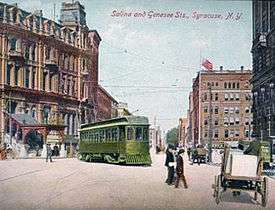
The city operated its first electric car in 1889 over the lines of the Third Ward Railway Company to Solvay.[4] In 1894, the Tracy Street power house was under construction and completed in 1895 at a cost of $200,000. Up until this time, many rails had to find their own source of electricity. The Syracuse and East Side lines had a complete power house at the east end of the village of East Syracuse.[5]
Growth in the city wards and suburbs followed the early trolley lines. The southern part of the city was built up for miles while vacant lots closer to the center of the city "went begging for lot buyers" because the South Salina street line was the first to give frequent service. University Hill, the eastern part of the city and southwestern sections "all woke to life as they felt the pulsing of these iron arteries."[4]
The street railroad as a real builder of the city did not begin until the later years, "when the policy of laying tracks into unoccupied territory and growing up with the section was adopted by the Rapid Transit Company."[4]
By 1889, there were twelve separate and distinct lines of railway which were the nucleus of the "single system" in place by 1908. The lines included the Central City, the Syracuse and Geddes, Syracuse and Onondaga, Genessee and Water Street, Fifth Ward, Syracuse and Oakwood, Seventh Ward, Woodlawn and Butternut Street, Burnet Street, Third Ward and the People's Railroad.[4] Between 1899 and 1917, a number of interurban lines came under the control of the Beebe Syndicate, an affiliation of companies with shared management founded by banker Clifford D. Beebe.
The interurban ran longer distances between upstate New York cities and included Syracuse, Watertown and St. Lawrence River Railroad and Rochester, Syracuse and Eastern Railroad.[5]
Patronage on the interurban and streetcar lines began to decline in the 1920s, due to more modern forms of transportation such as automobiles, buses and airplanes. Additionally, paved roads reduced the need for train tracks. After the stock market crash in the late 1920s, interurban routes were abandoned along with many unprofitable city and suburban routes.[6]
By 2010, public transit in the Syracuse area had been in existence for 150 years. The following list of local interurban rail, streetcar and trolley companies is in chronological order:
Street railway
Central City railway
The Central City Railway was chartered on April 19, 1859, and was the first street railway company in Syracuse, New York. It began operations in August 1860.[5]
The line was discussed for many years before it was actually constructed as a link between the First Ward and Erie Canal at Salina Street. The route was originally designated in the charter to run through Lodi Street, Lock Street and Wolf Street, but it was subsequently changed to Salina Street.[7]
During 1890, the company merged with People's Railroad[5] which merged again into Syracuse Rapid Transit Railway in 1896.[8] By 1948, the company was part of the Syracuse Transit Corporation.[9]
Syracuse, Eastwood Heights and DeWitt railroad
The Syracuse, Eastwood Heights and DeWitt Railroad was established in 1859. This was one of the most important of the first lines and operated as a steam road.[5] The company was awarded the operation rights for the Burnet Avenue route as well as the Burnet Street Car Company.[10]
The company owned 9 miles (14 km) of street railway track extending from a point on Burnet Avenue in the city of Syracuse to the village of East Syracuse and from a point on James Street, near Sedgwick Street, connecting with a former branch near East Syracuse. They went into receivership in June 1894.[11]
People's railroad
In 1860, People's Railroad was the first horse-drawn street railway in the city.[1]
Some records show People's Railroad was founded in 1887.[5] On November 1, 1890, this company took a perpetual lease of the Central City Railway and the Syracuse and Onondaga Railway and those lines then merged into the company.[12] That same year the Syracuse and Oakwood Railway also merged with the company.[4]
The company was one of three different railways that were awarded operation franchise rights to run cars in James Street.[10]
On May 21, 1896, the Syracuse Rapid Transit Railway, an interurban rail, was chartered as a consolidation of the Syracuse Street Railroad Company, the Syracuse Consolidated Street Railway Company and the People's Railroad Company which was formerly leased to the new company.[8]
Syracuse and Onondaga railway
The Syracuse and Onondaga Railway, a horse-drawn city railway, was chartered on April 29, 1863, and opened on July 25, 1864,[4] in Syracuse, New York.[13] The line commenced in Downtown Syracuse at Washington Street and terminated at Oakwood Cemetery at Brighton Avenue where it connected with the Onondaga Valley Railroad.[14] By 1890, the total length of the road was 2 miles (3.2 km).[15]
In late 1890, the company merged with People's Railroad and ceased to exist.[12]
Request for edit: Since Brighton Ave. does not come near Oakwood Cemetery, it appears there is some error here. If so, it should be corrected. If not, this should be explained. Also, it would be helpful to know where Danforth, Onondaga Hollow, Candee Corners and Hopper Glen were, in elation to currently named sites.
Syracuse and Geddes railway
The Syracuse and Geddes Railway, a horse-drawn trolley in Syracuse, was chartered on July 10, 1863. The line ran from Syracuse to Geddes, a suburb.[14] The company merged with Syracuse Consolidated Street Railway in 1890, after an agreement was made that allowed the new company to lease the lines.[7]
Oakwood Street railway
The Oakwood Street Railway was opened in 1863 and was a horse-drawn line.[16]
On the evening of April 26, 1865, after Abraham Lincoln's funeral procession through the city, the roads made special accommodations to their operating schedule and were running cars every half-hour "so that all will be taken home who come in on the road."[17]
The line was renamed the Syracuse and Oakwood Railway in 1871 and merged with People's Railroad in 1890.[4]
Genesee and Water Street railroad
The Genesee and Water Street Railroad was established in 1865.[5] The company was one of three different railways that were awarded operation franchise rights to run cars in James Street. The company also secured the franchise to operate cars in Westcott Street, to South Beech Street, Euclid Avenue, College Place, University Place, Walnut Avenue and Madison Street.[10]
The company merged with Syracuse Consolidated Street Railway in 1890, after an agreement was made that allowed the new company to lease the lines.[7]
Fifth Ward railroad
The Fifth Ward Railroad was a street trolley line in Syracuse, New York,[5] and was originally approved for construction by New York State in 1850; however, the rail was not chartered until 1867 and finally opened for business in 1868.[18]
The city railway extended from Railroad Street through Clinton, Walton, West, Gifford, Geddes and returning in a loop through Delaware, Holland and Niagara to Gifford Street, a total distance of 3 miles (4.8 km) in the city's Near Westside.[7] By 1875, the road extended from Washington Street to South Street and Geddes Street.[14]
The company merged with Syracuse Consolidated Street Railway in 1890, after an agreement was made that allowed the new company to lease the lines.[7]
New Brighton and Onondaga Valley railroad
The New Brighton and Onondaga Valley Railroad, a horse-drawn street trolley line, was chartered on May 5, 1869 in Syracuse, New York.[5] The road was also known as the New Brighton and Onondaga Railroad.[13]
The company merged with Syracuse Consolidated Street Railway in 1890, after an agreement was made that allowed the new company to lease the lines.[7]
Oneida Railway

The Oneida Railway was established in 1885 and eventually connected Oneida, New York, with Syracuse, New York. The interurban railroad used nontraditional third-rail pickup for power instead of the typical overhead catenary.[19]
In 1909, the system merged with the New York State Railways system, which was formed from the merger of several interurban railways in Upstate New York. Streetcar service on the line remained in operation until 1930 when it was abandoned in favor of buses.[19]
Burnet Street Railway
The Burnet Street Car Company was established in 1886.[4] A branch of the line commenced at the intersection of Catherine and Hawley and extended to Lodi Street, Burnet Avenue and ended at the city line. It was acquired by the Fourth Ward Railroad in 1888.[7]
Third Ward railway
The Third Ward Railway, a street trolley line in Syracuse, was established in 1886 and ran a distance of 4 miles (6.4 km) commencing in Park Avenue and terminating at Solvay Process Company in Solvay, a suburb.[7] A second extension was open for business on July 4, 1889, when a branch was added from West Genesee Street to the shore of Onondaga Lake, known as "lake shore."[7]
Syracuse was one of the first cities in the United States to adopt electricity as a transportation motive power. The city operated its first electric car in 1889 over the lines of the Third Ward Railway Company. An attempt was made to convert the old horse-drawn cars; however, this was not successful and in 1890, the company purchased complete new electric rail equipment and cars.[5]
The company merged with Syracuse Consolidated Street Railway in 1890, after an agreement was made that allowed the new company to lease the lines.[7]
Seventh Ward railroad
The Seventh Ward Railroad, a street trolley line in Syracuse, was established in 1886 and[5] held the city railway franchise rights to East Fayette Street.[10] The total length of the road was 3 miles (4.8 km).[15] The route followed Fayette Street from Salina Street to Montgomery Street, Jefferson, Grape, Kennedy, Renwick Avenue with final destination Oakwood Cemetery.[7]
The road was established by the same entrepreneurs as the Eleventh Ward Railroad which was laid on the same line on Fayette Street to Montgomery Street in 1889; forming a belt line with the Seventh Ward line. Both lines were also referred to as the Seventh and Eleventh Ward Railroad.[7]
The company merged with Syracuse Consolidated Street Railway in 1890, after an agreement was made that allowed the new company to lease the lines.[7]
Woodlawn and Butternut Street railway

The Woodlawn and Butternut Street Railway, a horse-drawn street trolley line in Syracuse, was established in 1886.[7] The road commenced at North Salina Street at the junction of James Street and traveled to Butternut street and Manlius Street with final destination, Woodlawn Cemetery.[7]
The company merged with Syracuse Consolidated Street Railway in 1890, after an agreement was made that allowed the new company to lease the lines.[7]
Fourth Ward railroad
The Fourth Ward Railroad, a street trolley line in Syracuse, New York, was organized in 1887[5] and opened in 1888. The company was one of three different railways that were awarded operation franchise rights to run cars in James Street.[10] The line commenced in James Street where it ran to Hawley Avenue, Green, Lodi and Willow.[7] The tracks in East Water street were laid by the Genesee and Water Street Railroad and were acquired by the road later that year.[7]
Another branch that commenced at the intersection of Catherine and Hawley and extended to Lodi Street, Burnet Avenue and ended at the city line was a franchise of the Burnet Street Car Company in Burnet Avenue and was acquired by the company in 1888.[7]
The company merged with Syracuse Consolidated Street Railway in 1890, after an agreement was made that allowed the new company to lease the lines.[7]
Eleventh Ward railroad
The Eleventh Ward Railroad, a street trolley line in Syracuse, was established in 1889 and[5] held the city railway franchise rights to East Fayette Street.[10] The line followed East Fayette Street to Montgomery Street and from there through Burt, Cortland Avenue, Midland Avenue, Colvin Street, Mulberry, Elizabeth, Baker Avenue and terminating on Kennedy street.[7]
The road was established by the same entrepreneurs as the Seventh Ward Railroad which was laid on the same line on Fayette Street to Montgomery Street in 1886; however, from there it continued to Jefferson, Grape, Kennedy and Renwick Avenue with final destination Oakwood Cemetery, forming a belt line with the Eleventh Ward line. Both lines were also referred to as the Seventh and Eleventh Ward Railroad. These two lines were the first in the city to adopt regular schedule ten-minute time.[7]
The company merged with Syracuse Consolidated Street Railway in 1890, after an agreement was made that allowed the new company to lease the lines.[7]
Syracuse Consolidated Street railway
The Syracuse Consolidated Street Railway was chartered on May 22, 1890, in Syracuse. On July 1, 1890, the company leased, in perpetuity, several street railroads in the city including Third Ward Railway, Fourth Ward Railroad, Fifth Ward Railroad, Seventh Ward Railroad, Eleventh Ward Railroad, Genesee and Water Street Railroad, Woodlawn and Butternut Street Railway, Syracuse and Geddes Railway and New Brighton and Onondaga Valley Railroad. The rail ran a total distance of 24 miles (39 km) and had branches every 3 miles (4.8 km).[12]
At the time of the consolidation, the rail included all the roads in Syracuse except the Central City Railway, the Syracuse and Onondaga Railway and the People's Railroad.[7]
The company filed for bankruptcy in 1893.[8] On May 21, 1896, the Syracuse Rapid Transit Railway was chartered as a consolidation of the Syracuse Street Railroad Company, the Syracuse Consolidated Street Railway Company and the People's Railroad Company which was formerly leased to the new company.[8]
Interurban railway

In April 1921, union trolley workers numbering more than 6,000 on all lines entering Syracuse were asked to accept a wage reduction of 25 percent. Employees on all four lines entering the city rejected the proposal. This included the Empire State Railway, New York State Railways, Syracuse Northern Electric Railway, Auburn and Syracuse Electric Railroad and Rochester and Eastern Railroad.[20]
By 1978, rights-of-way of the major interurban lines "that stretched west, north and east" were still visible in many sections of Onondaga County. The remains of "once-sturdy" bridges that carried the high-speed trolleys across creeks and other rails still remain in many areas.[3]
One of the few remaining "eight-sided" waiting stations "that protected passengers at stops between main stations" was situated on a golf course near Baldwinsville. Another was located on East Seneca Turnpike near Marcellus as late as 1971.[3]
Syracuse and Oneida railroad
The Syracuse and Oneida Railroad, an interurban rail, was incorporated on October 11, 1891, with a capital of $125,000. The company built a road 12 miles (19 km) in length from Messina Springs connecting with the Syracuse, Eastwood Heights and DeWitt Railroad Company's road and ran northerly by the "most direct and feasible route" through the towns of DeWitt and Cicero, at a point near the south shore of Oneida Lake.[21]
Syracuse and East Side Street railway
The Syracuse and East Side Street Railway, an interurban rail, was chartered on August 25, 1894, and was a successor to the Syracuse, Eastwood Heights and DeWitt Railroad Company.[8] It is sometimes called the Syracuse and East Side Railroad.
The company went bankrupt and was placed in receivership on May 11, 1898, and on December 29, 1898, the property was purchased by the bondholders.[8] The East Side Traction Company was chartered on January 14, 1899, after a reorganization of the company.[8]
Syracuse and Suburban railroad
The Syracuse and Suburban Railroad, an interurban rail, was chartered on June 29, 1895. The main line of this electric road, also known as Syracuse and Suburban Electric Railroad and the Syracuse and Eastern Railroad, ran 15 miles (24 km), extending from Syracuse, over the Genesee Street track[1] to Fayetteville and Manlius where it ended at Edwards Falls, a local tourist attraction. The railroad also operated a line that ran from Orville, now known as DeWitt to Jamesville for a total distance of 18.08 miles (29.10 km).[22]
On January 1, 1921, the rail, with lines between Syracuse and Fayetteville and Manlius, suspended operation at 1:00 A.M. due to lack of operating revenue. C. Loomis Allen, general manager, declared that unless there were changed conditions, the road would not resume and that readjustment of fares and wages of employees must be affected. That same day, a motor bus service was started pending formal grant of franchises for motor lines between the two villages and the city of Syracuse. The Chenango branch of the New York Central Railroad also stepped in to accommodate many passengers who had relied on the electric service.[23]
Syracuse Rapid Transit railway
The Syracuse Rapid Transit Railway, an interurban rail, began operations in May 1896. The company was a consolidation of the Syracuse Street Railroad Company, the Syracuse Consolidated Street Railway Company and the People's Railroad Company[8] that was called the Syracuse Railway Company.[24]
The company controlled the city street railway system of Syracuse and had extensions to Solvay, Onondaga Valley, Rockwell Springs, East Syracuse and Liverpool.[24]
In 1912, the rail merged with the New York State Railways, affiliated with New York Central Railroad.[24]
Syracuse, Lakeside and Baldwinsville railway
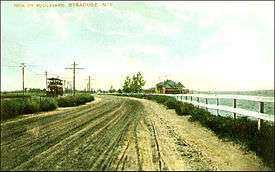
The Syracuse, Lakeside and Baldwinsville Railway began operations in 1898[1] and provided service along the shore of Onondaga Lake. Due to dependence on summer traffic, the company did not prosper during the remainder of the first year.[25]
The road was built as a local investment both in construction and matters of finance. The majority of the construction took place in 1899, with the opening to Baldwinsville taking place on September 24 that year. Prior to that date, the road had been operated to lakeside resorts such as Pleasant Beach in Fair Haven on Lake Ontario.[4]
The company ran double-deck cars for several years which were a real novelty since they were the only ones in Central New York. They were eventually abandoned because of safety reasons.[4]
On December 12, 1903, the road fell into bankruptcy and Captain W. B. Rockwell was appointed receiver. In the summer of 1905 the road was purchased on mortgage foreclosure by Clifford D. Beebe for $530,000.[4] It was reorganized as the Syracuse, Lake Shore and Northern Railroad in 1905.[25]
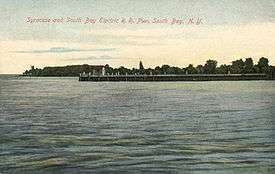
Syracuse and South Bay railway
The Syracuse and South Bay Railway, also known as the Syracuse and South Bay Electric Railroad, incorporated on May 10, 1900, was an interurban rail that ran from Syracuse, New York, through Cicero to Lower South Bay on the south shore of Oneida Lake, a distance of 12 miles (19 km).[26]
The line began in the city at the intersection of Wolf Street and Seventh North Street connecting at that point with the tracks of the Syracuse Rapid Transit Railway, running from there easterly along Seventh North Street about 200 feet (61 m) and running northeast by a right angle turn by private right of way across the tracks of the New York Central and Hudson River Railroad by an under crossing. From there, the rail headed northeasterly to the plank road to the town of Salina and Clay to the west line of Cicero thence by private right of way to Norcross Point on the east side of South Bay on Oneida Lake.[27]
The name was changed to Syracuse Northern Electric Railway Company by 1917.[28]
Auburn and Syracuse Electric railroad
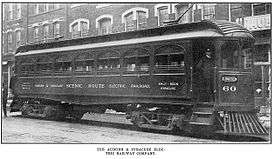
The Auburn and Syracuse Electric Railroad was formed in 1901 and by November 1905, the company had cars to Split Rock, Marcellus, Skaneateles and Auburn.[29]
The rail was part of the Beebe Syndicate, a group of 12 high-speed, interurban, electric train lines which ran from Buffalo, New York, through Rochester and Syracuse, then north to Oswego on Lake Ontario.[30]
By August 1911, the rail was providing vacation excursions to Upstate New York locations such as Skaneateles Lake which they advertised as "A Perfect Ride in Perfect Safety Searchlight Excursion." The trip was scheduled three times a week and included a 38 miles (61 km) "scenic" trolley ride and a 30 miles (48 km) "searchlight sail" and one hour of dancing at Ten Mile Point, New York.[31]
On weekends, the railroad ventured to Fair Haven instead of Skaneateles Lake. The roundtrip price was 75 cents, no matter the location or day and the main ticket office was located at 340 West Fayette Street.[31]

The company went bankrupt in 1927 and streetcar service in Auburn ended at that time, however, interurban service continued and the business was sold in 1930. Rail service was abandoned on April 15, 1930.[32]
Syracuse, Lake Shore and Northern railroad
The Syracuse, Lake Shore and Northern Railroad served the Oswego, New York, area and began operations in 1905 when it was formed from the Lake Ontario and Riverside Railway, which dated back to 1896 and was a system originally built by the Oswego Street Railway.[19] The line also merged with the Syracuse, Lakeside and Baldwinsville Railway that same year and the line was extended to Oswego.[25] The rail was part of the Beebe Syndicate, a group of 12 high-speed, interurban, electric train lines which ran from Buffalo, New York, through Rochester and Syracuse, then north to Oswego on Lake Ontario.[30]
By 1911, the company had 13 fast electric limited trains leaving Syracuse daily for Baldwinsville, Phoenix, Fulton, Minetto and Oswego.[33]
Financial issues in 1913 forced the company to merge with two other rails; the Auburn and Northern Electric Railroad and the Rochester, Syracuse and Eastern Rapid Railroad forming the Empire United Railways.[19] The rail was in use until 1916 when it became known as the Empire State Railroad Corporation. Streetcar service on the route ran until 1931 when it was abandoned in favor of buses.[19]
Rochester, Syracuse and Eastern Rapid railroad
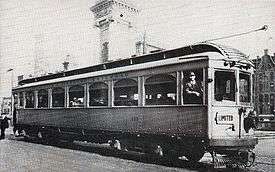
The Rochester, Syracuse and Eastern Rapid Railroad, also known as the Rochester, Syracuse and Eastern Railroad, an interurban rail, began operations in 1906 and linked Rochester, New York, with the nearby towns of Newark, Fairport and Palmyra. At its peak the railroad was 87 miles (140 km) in length and employed third-rail for power instead of the more traditional overhead catenary.[19]
The rail was part of the Beebe Syndicate, a group of 12 high-speed, interurban, electric train lines which ran from Buffalo, New York, through Rochester and Syracuse, then north to Oswego on Lake Ontario.[30]
Financial issues in 1913 forced the company to merge with two other rails; the Auburn and Northern Electric Railroad and the Syracuse, Lake Shore and Northern Railroad forming the Empire United Railways. The new company was not successful and was split up in 1916 and the Rochester, Syracuse and Eastern Rapid Railroad (RS&E) became the Rochester and Syracuse Railroad which remained in operation until 1931 when it was abandoned.[19]
Rochester and Syracuse railroad
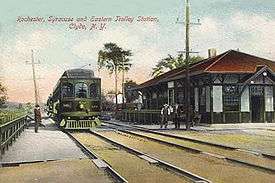
The Rochester and Syracuse Railway, Inc., of Syracuse, New York, was incorporated as the successor to the Rochester, Syracuse and Eastern Railroad, the property which they sold under foreclosure on August 28, 1917.[34]
The rail was part of the Beebe Syndicate, a group of 12 high-speed, interurban, electric train lines which ran from Buffalo, New York, through Rochester and Syracuse, then north to Oswego on Lake Ontario.[30]
The company acquired control of the Empire State Railroad in 1922. In 1930, the company leased the Port-Byron-Auburn line after the abandonment of the direct interurban between Syracuse and Auburn, however this was short lived as the entire R&S line was abandoned on June 27, 1931.[35]
New York State railways
New York State Railways, formed in 1909, was a grouping of several large city streetcar and electric interurban systems in upstate New York. It included the city transit systems in Rochester, Syracuse, Utica, Oneida and Rome, plus various interurban lines connecting those cities.
The company was formed when the New York Central Railroad (NYC) consolidated its previously purchased (in 1905) with several interurban companies in Rochester. In 1912 it added the Rochester and Suburban Railway, the Syracuse Rapid Transit Railway, the Oneida Railway and the Utica and Mohawk Valley Railway In effect, the big steam railroad system (NYC) was able to monopolize local and intercity passenger business along its Mohawk Valley mainline. The company discontinued streetcar service in 1941.
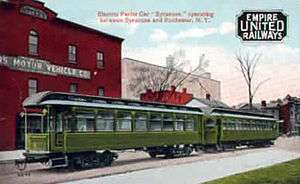
Empire United railways
The Empire United Railways was established in 1912 after the Auburn and Northern Railroad and the Rochester, Syracuse and Eastern Rapid Railroad consolidated.[25] In 1913, Syracuse, Lake Shore and Northern Railroad was merged into the company.[35]
The rail was part of the Beebe Syndicate, a group of 12 high-speed, interurban, electric train lines which ran from Buffalo, New York, through Rochester and Syracuse, then north to Oswego on Lake Ontario.[30] The line had an "electric parlor car" named Syracuse in 1912 that made runs between Syracuse and Rochester.
The company was consolidated into the Empire State Railway in 1917.[25]
Empire State railway
The Empire State Railroad Corporation was formed on October 30, 1916, to take over part of the property of the Empire United Railways, Inc..[34]

The new company took over the property from the receiver on October 31, 1916. The firm owned the interurban electric railway known as the Empire State Railway that ran between Syracuse and Oswego, including the local electric railway system in Oswego and the Syracuse terminal. The Rochester and Syracuse Railroad used the Syracuse terminal under a rental agreement.[34]
The Empire State Railroad Corporation also owned the interurban electric railway extending from Auburn to a connection with the Rochester and Syracuse Railroad at Port Byron, New York, 26 miles (42 km) west of Syracuse. They also owned part of the local electric railway system in Auburn which was operated by the Auburn and Syracuse Electric Railroad. The total track owned by the Empire State Railroad Corporation was 83 miles (134 km), of which 70 miles (110 km) was interurban and 13 miles (21 km) city track. Power was supplied by the Niagara, Lockport and Ontario Power Company from Niagara Falls, Salmon River and Oswego River hydro-electric developments.[34]
Syracuse Northern Electric railway
The Syracuse Northern Electric Railway, also known as Syracuse and Northern Electric Railway, came out of the Syracuse and South Bay Railway Company[28] The road was in business by 1917 when the directors authorized the sale of four miles of track from Watertown Junction to South Bay, New York. The double-track lines were torn up and replaced with a single-track line. The section of rail was sold for $30,000.[34]

Regional line
OnTrack
OnTrack was a regional rail line that operated in Syracuse, New York, from 1994 to 2007. During its operation, Syracuse was the smallest city in the United States to have regional train service. The line ran from Colvin Street on the city's south side via Syracuse University and Armory Square to the Carousel Center, using four Budd Rail Diesel Cars (RDC-1) built in the 1950s. It was operated by the New York, Susquehanna and Western Railway.[36]
Advertisements
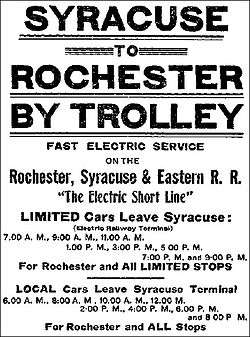 Rochester, Syracuse and Eastern Railroad - "Syracuse to Rochester by trolley" - Syracuse Herald, December 27, 1909 |
 Found in Rapid Transit Cars - Syracuse, New York - October 11, 1910 |
 Auburn and Syracuse Electric Railroad - Searchlight Excursion to Skaneateles Lake - August 7, 1911 |
References
- 1 2 3 4 5 6 "Certification Review" (PDF). Syracuse Metropolitan Transportation Council, November 2002. Retrieved February 19, 2011.
- ↑ "Remember the Age of the Interurban Trolley?". The Post-Standard. Syracuse, New York. July 1, 1951.
- 1 2 3 Lawless, Don (April 13, 1978). "Once Upon a Trolley". The Post-Standard. Syracuse, New York.
- 1 2 3 4 5 6 7 8 9 10 11 12 Beauchamp, Rev. William Martin. Past and present of Syracuse and Onondaga county, New York (Volume 1). New York: S. J. Clarke Publishing Co., 1908, pg. 489. Retrieved January 14, 2012.
- 1 2 3 4 5 6 7 8 9 10 11 12 13 "First Streetcars Operated Here in 1860". Syracuse Herald. Syracuse, New York. December 14, 1922.
- ↑ "Utica & Mohawk Valley Railway Company". Stocklobster.com, 2006. Retrieved February 19, 2011.
- 1 2 3 4 5 6 7 8 9 10 11 12 13 14 15 16 17 18 19 20 21 22 23 24 Bruce, Dwight Hall. Memorial history of Syracuse, N.Y., from its settlement to the present time. Electronic Library, 2011. Retrieved July 5, 2011.
- 1 2 3 4 5 6 7 8 American street railway investments. The Street Railway Publishing Company, 1899 p. 262. Retrieved February 18, 2011.
- ↑ Hillenbrand, Dick. "A List of Syracuse Businesses". Rootsweb, March 4, 1999. Retrieved February 19, 2011.
- 1 2 3 4 5 6 "Study for Bus Franchise Recalls Early Trolley Lines". Syracuse Herald-Journal. Syracuse, New York. May 23, 1940.
- ↑ "Receiver Sale". The Evening Herald. Syracuse, New York. May 17, 1894.
- 1 2 3 Poor, Henry Varnum. Manual of the railroads of the United States, Volume 27. Poors, 1894 p. 262. Retrieved February 18, 2011.
- 1 2 Poor, Henry Varnum. Manual of the railroads of the United States, Volume 22. Poors, 1889 p. 85; 317. Retrieved February 4, 2011.
- 1 2 3 Boyd's Syracuse Boyd's City Directory 1875. Andrew Boyd, 1875.
- 1 2 Whipple, Fred H. Whipple's Electric, Gas and Street Railway Financial Reference Directory. Electronic Library, 2011. Retrieved July 5, 2011.
- ↑ "Events in City's History 1848–1897". Syracuse Herald. Syracuse, New York. October 10, 1897.
- ↑ "Oakwood Street Railway". Syracuse Daily Courier And Union. Syracuse, New York. April 27, 1865.
- ↑ Laws of the State of New York, Volume 1. New York State, 1868 p. 262. Retrieved July 5, 2011.
- 1 2 3 4 5 6 7 "New York Interurbans and Streetcar Railroads". American-rails.com, 2007. Retrieved February 16, 2011.
- ↑ "Conference on Wage Question Within a Week". Syracuse Herald. Syracuse, New York. April 15, 1921.
- ↑ "All Around Town". Albany Dispatch. Albany, New York. October 11, 1891.
- ↑ McGraw electric railway manual: the redbook of American streetcars. Volume 13. American Street Railway Investments, 1906 p. 253. Retrieved February 18, 2011.
- ↑ "Syracuse Line Quits for Lack of Revenue". The New York Times. New York, New York. January 2, 1921. Retrieved February 19, 2011.
- 1 2 3 "Rapid Transit Formed in '96". The Post-Standard. Syracuse, New York. July 18, 1904.
- 1 2 3 4 5 Polston, Jeff (2010). "JeffPo's Empire State Railroad Lantern Page". JeffPo's Universe. Retrieved March 3, 2010.
- ↑ "Syracuse-South Bay Railroad". The New York Times. New York, New York. May 11, 1900. Retrieved March 10, 2011.
- ↑ "Public Notice". The Post-Standard. Syracuse, New York. January 23, 1905.
- 1 2 "152 Miles of Deserted Rights of Way Radiate from Syracuse". The Syracuse Herald. Syracuse, New York. November 5, 1933.
- ↑ "The Railroad Roster". The Post-Standard. Syracuse, New York. November 21, 1905.
- 1 2 3 4 5 "Perinton Hike-Bikeway". Foot Print Press, Inc., 2011. Retrieved March 5, 2011.
- 1 2 "A Perfect Ride in Perfect Safety". Syracuse Herald. Syracuse, New York. August 7, 1911.
- ↑ "New York Trolley Lines". Don Ross Group, 2011. Retrieved March 6, 2011.
- ↑ "Fast Limited Every Hour to Oswego". Syracuse Herald. Syracuse, New York. October 8, 1911.
- 1 2 3 4 5 Electric railway journal, Volume 50. McGraw-Hill Publishing Company, Inc., December 1917, pg. 1100. Retrieved February 4, 2011.
- 1 2 Hilton, George W.; Due, John. The Electric Interurban Railways in America. Stanford University Press, 1960, p.314. Retrieved March 4, 2011.
- ↑ "Syracuse: When Rail Fails". Metro Jacksonville, 2008. Retrieved February 14, 2011.
External links
| Wikimedia Commons has media related to Railroad in Syracuse, New York. |